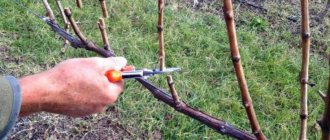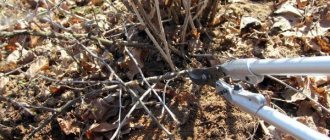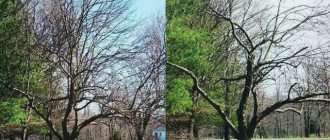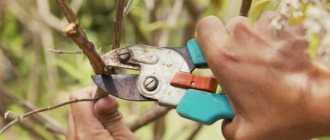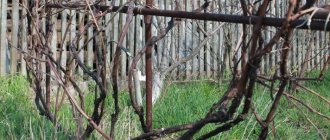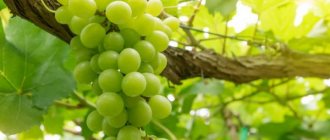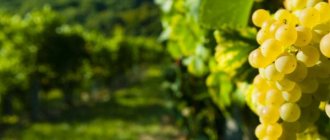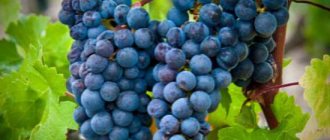What is the formation of a grape plant
The life period of a grape bush is conventionally divided into three stages:
- growth, gain of vegetative power (lasts 5-6 years);
- active fruiting (25-50 years);
- weakened growth, decreased reproductive activity.
Fruiting and aging depend not only on the climatic conditions of the area, nutrition, care, but also pruning of bushes. On liana-like plants, shoots appear in the most unexpected places, and to increase the number of clusters it is necessary to form a bush.
Shaping is the pruning of grape shoots according to certain patterns, which take into account the variety, characteristics of the bush, and other factors.
Remove:
- stepsons of no particular importance;
- diseased and deformed shoots;
- extra buds.
Thanks to the procedure, nutrition is redistributed and the main fruit-bearing vines are provided with the necessary elements.
The need to form vineyard bushes
Pruning bushes is a labor-intensive but important procedure to increase crop yields. In addition, thanks to the formation:
- simplifies planting care;
- the risk of infections is reduced;
- the taste of berries improves.
Strong, robust bushes are able to withstand adverse loads and avoid freezing even in harsh climatic zones. Properly pruned bushes produce more berries, and there are no difficulties when collecting bunches.
In the absence of pruning, the berries gradually become smaller, the taste deteriorates every year, and the yield per bush decreases. Plants do not tolerate cold periods well and get sick more often.
Basic conditions for choosing a formation scheme
The shoots are cut according to certain patterns. Several options for removing branches of grape bushes have been developed and put into practice. The choice is determined by:
- the climate of the area where grapes are grown;
- soil type;
- speed of shoot development;
- the main characteristics of a particular variety;
- the need for shelter for the winter.
The parameters of accumulation of woody mass of bushes and soil fertility are taken into account. On poor soils where there are problems with watering, bushes with a small number of sleeves are grown. For fertile soils with abundant watering, any shape is suitable, including those with numerous sleeves.
In cold regions, grapes require shelter in winter, so they choose the most suitable schemes for bending down the shoots. In central Russia, where winters have little snow and strong winds often blow, bushes are covered entirely. In the northern regions (Urals, Siberia, North-West) winters are colder and longer, so they practice their own pruning methods.
Choice of grape shape
A very important and responsible moment for a beginning winegrower.
- The first thing we need to do is decide on the issue of covering the vineyard in winter. If we cover, then we choose a formation for a covering vineyard, if not, then an uncovered one.
- Then we determine the distances between the bushes and the size of the row spacing. The greater both of these distances are, the more powerful the formation can be used.
For beginners from the northern regions of covered viticulture, I recommend not to reinvent the wheel, but to opt for three methods of maintaining a grape bush, proven by many winegrowers:
- horizontal cordon
- fan
- sleeveless capitate type uniform
If the distance between the bushes is 3 meters or more, you can safely use the mountains. cordon or six-armed fan, less than three meters - four-armed fan, less than 1.5 meters - two-armed fan or sleeveless uniform.
It is these formations that we will focus on in further materials on the site.
The arched form is also present in my vineyard as a living green roof for a gazebo, but it performs more of a sun protection function; we will also analyze this in detail.
But for winegrowers of the southern non-covering regions, a wider choice of formations opens up, but the above forms are extremely popular there, along with arched and high-standard formations.
So we, friends, have superficially become acquainted with the types of shaping a grape plant, learned why grapes are pruned, and looked for a suitable form of maintaining a bush for ourselves.
With this article I open a series of materials devoted to the formation and pruning of grapes. Each formation will be examined in detail by us, studied and clearly demonstrated from a seedling to a fully formed bush. You will learn how grapes are correctly formed and subsequently pruned annually, how a fruit unit is created with and without a replacement knot.
Stay with us, subscribe to the mailing list, join our group on Odnoklassniki, and you will receive the latest site news in your mailbox or social news feed. networks.
Author: Dmitry Dutko, author of the video A. Mchedlidze
Subscribe to the Vinogradnik.by newsletter by Email
RELATED SITE MATERIALS:
- Forming and pruning fan-shaped grapes +VIDEO
- How to prune grapes correctly, VIDEO for beginners
- Forming and pruning grapes, horizontal cordon +VIDEO
- How to prune an old neglected grape bush +VIDEO
- How to determine the degree of ripening of a grape vine? +VIDEO
- Subtleties of grape pruning for beginners, fruit section +VIDEO
- Trimming and shaping the arbor shape of grapes +VIDEO
- Pruning an incorrectly formed grape bush VIDEO
Features of culture growth
When choosing a scheme, the general characteristics of the culture are taken into account:
- Grapes have no fruiting branches. Each branch can produce a harvest under certain conditions, and the result depends on pruning.
- There are shoots of the first year (summer), biennial (usually clusters of the main crop are formed on it), and perennial.
- The vine can be standard or non-standard type. The first is common in the southern regions, characterized by raised arms (fruit-bearing vines). The second type - the bush grows with fan-type sleeves; stakes (bowl) or trellises are used for supports.
- The stem is a perennial part, a shoulder.
- The sleeve is a perennial shoot located on the shoulder.
- Arrows or fruiting vines are biennial branches.
The location of the shoulders or cordons varies, depending on the climate of the region. They have one thing in common - they are located horizontally to the surface of the earth, while the height of the sleeve and shoulder can be high, medium, low.
Grape pruning technique
For pruning grape plants, use pruning shears, a grape saw (hacksaw), a garden knife, fine-grained whetstone for straightening the knife, pruning shears while working, and a clean cloth for wiping tools.
The quality and cleanliness of cutting largely depends on the serviceability and necessary preparation of the tools used. The pruning shear blade must be well sharpened and lubricated; no traces of rust or dirt are allowed.
The garden knife is designed for cutting vines up to 2 cm thick and straightening the cuts made with a file.
When pruning, the pruning shears must be held so that the knife is facing the part of the shoot that is being left, and the stop is facing the part that is being removed. Cuts must be made not with the end of the pruning knife, but with its base. With this position of the pruning shears, the bark and wood are not damaged or crushed, and the cuts are smooth.
Basic schemes for bush formation
The fruit plant is pruned in certain ways, ensuring ventilation, a sufficient level of lighting, and stability of the bush.
Sleeve pattern
Plants pruned using the sleeve method have a short lifespan. But for small areas this option will be convenient and most acceptable.
Suitable for regions with harsh climates, cold winters, and strong winds. Parts of the plant are cut off annually, otherwise there is a nutritional deficiency and, as a result, the death of the plantings. In the first season, all branches are removed, leaving only the strongest and most densely growing ones (long and short). The number of buds on the long one is 7-9, on the short one – 2-3 pieces. In the autumn of the second year, the long branch is cut off. The short one leaves only strong arrows.
Fan shape
The scheme is similar to the sleeve one, but the gardener will have to grow at least 5-6 sleeves. The name is given because of the similarity of the resulting shape to a fan, since there are more branches on the plant. Location - on both sides of the root.
In two seasons it is required to grow two strong, powerful vines. Vertical garter. The arrangement on the support is fan-shaped; a couple of shoots are left for lengthening. By length, large, medium and small vines are distinguished.
The fan pattern is popular among winegrowers, as it is suitable for many varieties of crops. They use faiths when growing plants on trellises and stakes.
Cordon form
The time it takes to create a bush shape is about four years. To begin with, the growing branches are thinned out, leaving a distance of 30 to 42 cm between them. Leave long sleeves and use all the vines.
It is necessary to grow a strong, powerful stem in the first two years, then cut it at a certain distance and tie it arbitrarily to a support (trellis, trellis).
On a note! There are three types of cordons: vertical growth, horizontal growth and oblique growth.
In the third year, they begin to grow arrows on the sleeve, thinning them, removing weak and diseased specimens. In the 4th year they begin to work with the fruit link.
Using the Guyot scheme
A relatively simple scheme for pruning a vineyard using the Guyot method. Using it, juicy, large crops are obtained, while the overall yield increases.
Molding options - with one or two shoulders. In the first case, they form a single small shoot with a well-developed fruit bud. When two shoulders are left, two sleeves with stepsons grow.
Guyot with two shoulders is suitable for growing vineyards on poor soils when the bushes are weak-growing. Planting with one shoulder is practiced in dense patterns, where the distance between plants is 1-1.2 meters.
Moser formation
The scheme was named after the famous Austrian winegrower Lorenz Moser. The cultivation method is mainly used in industrial viticulture, noting the intensity of the technology. In amateur gardening, the method was modified, taking into account specific climatic conditions.
The essence of Moser's formation: the use of trunks, height 1.2-1.3 meters. The system of guiding green vines has been changed, instead of a vertical arrangement, free hanging is used. This gives moderate growth of the vine and simplifies the care of the crop. Tying is done only for some branches to avoid bending of the branches and falling of the bunches.
Formation according to the type of bowl
The scheme is used in the vineyards of the southern regions. The placement of the sleeves, as well as the number, varies. The number depends on the potency of the plant, the type and fertility of the soil. Most often, 3-6 pieces are left.
Formed within 5-6 years. The scheme for the main stages is similar to fans, but branches of all plants are left for growth.
Formation of VNIFS-1
The name of the scheme was received in honor of the anti-phylloxera research station, whose employees proposed their own version of pruning the vine.
Short arrows are left on the sleeves that do not carry substitution knots. The distance between plants when planting is 2-2.5 meters. Intermediate anchors are made onto which the trellis wire is pulled. In the second season, all branches over a meter long are tied to supports. Weak shoots are left until next season. They cut the vine into 3-4 eyes, after which they begin to create fruit links.
Standardless small fan
In the group of covering schemes, a promising method developed by gardener D. Tokarev is popular. It is used in small areas when it is important to save space.
Plants are planted at a distance of 0.8-1 meters; a distance of up to two meters is left between rows. Shelter provides protection, and the grapes quickly regenerate.
On a note!
Forming begins from an early age of the vine, when the shoots are flexible and bend easily.
Formation of a trunk
The method is relevant for southern territories, where the risk of vineyard freezing is eliminated. It will take 5-6 years for complete molding, then it is necessary to maintain the created shape of the plant.
The standard version allows you to solve many problems when cultivating plants. For example, with this method, grape plantings are less likely to be affected by infections and pests.
Forming work in the first year
They grow a single strong shoot, identifying strong branches on it. One branch is left to grow, the rest are cut off. For the winter, the grapes are wrapped, otherwise the vine will freeze.
Forming for the second year
The strong pillar of last season becomes like a standard. Carry out control pruning, leaving a branch of the desired size and adding a distance of 2-4 eyes.
After minting, two stepsons remain, growing by about 30 cm over the summer.
Forming for the third year
The stepsons formed at the second level are cut off. Only the upper buds are left, then the arrows that grow from them are thinned out and tied up.
Forming for the fourth year
The shoot closest to the ground is cut off, leaving no more than three eyes. This will be the replacement stem (knot). A fruit shoot is formed from a higher growing vine and cut into 6-10 buds.
What types of vineyards are there?
The bush can be MULTI-ARMED, or fan-shaped.
His shoulders can be both short and long. They are intended for trellises or. They are usually formed for gazebos and arches. The standard can be different, from high to completely absent.
Also the shape of the bush can be
Fan Short Sleeve
It is important to be able to correctly distribute the branches of the sleeves and not thicken the bush.
Cons: the bush is limited in the development of its power.
A small supply of woody vines.
It is inconvenient to cover the bush due to the large number of horns.
The location of bunches and shoots close to the ground promotes the development of diseases.
When caring for a plant, you must bend down.
Plus one: I usually use this formation in cramped and low-lying places. Although it is better not to use this arrangement for growing grapes.
For gazebos, as a rule, a molding is used
Gazebo Long Sleeve Fan
The bush grows only along the perimeter of the gazebo area.
The fruit links are evenly distributed over the support.
The bush has a lot of wood. It is convenient to care for the bush. When covering, it is easy to lay the vine on the ground.
Due to the fact that the shoots and shoulders that are located higher grow more strongly over time, they take over the bush.
The lower shoots become weaker and become bare.
Fan shape of bushes
involves 2 or more shoulders, which are arranged in the shape of a fan relative to the level of the trellis.
There are no stamps for such formations.
There are short fan designs with 2-4 small sleeves. As a rule, their length 3 is from 30 to 40 cm, 4-6 shoulders are usually medium. Their length is approximately 40-60 cm. Large - the sleeves can be about a meter or more long.
Forming without standard multi-sleeve fan
Number of sleeves: 4 to 6 pieces, the length of which reaches from 40 to 60 cm or more;
the shape of the bush looks like a fan, the shoulders are inclined towards the ground.
In this method, 1-2 replacement branches are left.
Accelerated formation of grape bushes
The schemes are used for the rapid entry of young vineyards into the fruiting stage. Kinds:
- N.I. method Sklyara;
- scheme of stepsons (author F. Bashirov);
- method of the Scientific Research Institute "Magarach" (vine bending).
"Green" formation
Recommended for fertile soils and subject to the rules of agricultural technology. The tops of young plants are pinched, then a couple of emerging stepsons are left. In the second year, replacement knots, fruit shoots, are created from these stepsons. In the 4th year they get a full harvest.
Bend of the vine
The strong shoots that grew in the first year are cut off in the spring of the second year by 2-3 eyes. Over the summer, stepchildren will appear from them.
In the third year in the spring, the stepsons are pruned:
- a couple of pieces for 12-15 eyes;
- the rest are cut into 2 eyes.
Long ones are tied to a support to create a bend in the vine. The next year, those parts of the stems that produced the harvest are cut off. Shoots from part of the curved vine are used to create a fruiting unit.
Peculiarities of pruning grapes in northern viticulture zones
In the northern viticulture zones, in years with a cool, rainy spring-summer period, with the manifestation of the fungal disease oidium, the productivity of the leaf apparatus sharply decreases, the rate of accumulation of organic reserve substances in green shoots decreases, and their ripening slows down. In such years, autumn pruning and covering of bushes should be carried out in a short time, before the onset of the first autumn frosts at -3...-4°C, which cause irreversible damage to immature vines and eyes.
In individual grape plantings in such unfavorable years, it is possible to achieve a significant accumulation of assimilates in the shoots, ensure their proper outflow into perennial wood, and increase the winter hardiness of plants by covering them with plastic film in arcs from August 15 to October 10.
In years with warm summers and warm, moderately humid autumns, with fairly successful ripening of the vines, early autumn frosts of -3...-4°C do not significantly damage them. In such years, pruning and covering can be carried out even after frost, but certainly before the onset of a stronger frost, at -7...-8°C, which causes severe damage to the annual and perennial wood of the bush and leads to the death of a significant part of the fruit buds. Damaged eyes and vines under any reliable shelter completely rot away during the winter.
When pruning vineyards early (several days before the appearance of autumn frosts) that are not damaged by fungal diseases, it is recommended to leave as many living leaves as possible on the shoots.
When pruning late (on the eve of frost), leaves on the left vines that are not damaged by fungal diseases can be preserved to improve the cover of plants for the winter. If the leaves are damaged by unexpected frosts, pruning and covering the grapes should be done within a short time, so as not to subject them to another, more severe frost. Young bushes up to five years of age, as well as fruit-bearing, weak ones, with poorly ripened wood, should be pruned in the spring, since in an unpruned state they survive wintering more successfully.
Formation methods using trellises
In the south, vineyards are often grown on trellises. They equip two-plane structures, due to which the yield increases by 20-40%.
It is required to follow the rules of planting, placing the seedling in the hole so that the lower bud is 10-12 cm above the ground surface. A popular pattern is a fan with sleeves, without a standard.
Leave a distance of 2-3 meters between the rows.
Formation in the first year
Get four strong shoots, removing all the others. In the fall, the stepsons are pruned, the length is 70-80 cm. For the winter, the vines are covered with shields and non-woven materials. If the shoots are weak, buds are left on them, which will produce the necessary branches next year.
Formation in the second year
The number of stepchildren is increased to six. A shoot is left, which will then play the role of a horizontal trunk. Attach it to a trellis and cut it into 8 buds.
If it is necessary to form a trunk on both sides, choose a strong stepson; all the stems located below are used for replacement.
The entire upper part of the plant is cut off. In spring, two strong shoots are cut into 3 eyes. The total number of sleeves is left to 5-6 pieces.
Third year from planting
It is in the third year that the first harvest is expected. The care of vegetation is changing slightly due to new requirements. In the spring, a trellis is built to support the bushes. The trellis for this formation usually consists of four tiers, with two wires positioned synchronously. All other spring work is carried out according to the same scheme. It is in this year that a one-sided fan is formed. Summarizing
There is no one proven scheme that would give you an intensive harvest - all the necessary knowledge is acquired only with experience
This is a brief overview of the one-way fan formation of a vineyard. For complete information, it is necessary to use special literature and, of course, advice from professionals. For each region, region, country, separate types of vineyards and formation options are suitable. There is no one proven scheme that would give you an intensive harvest - all the necessary knowledge is acquired only with experience. What is ideal for one winegrower is completely unacceptable for another. If you decide to seriously engage in this activity, then only your patience, observation and, to some extent, optimism will help you learn how to properly breed plants and protect them from diseases in time. Only personal desire can mold you into a professional gardener who is ready to share his experience over time. Along the way there will be both successful moments and many failures, and if you don’t give up, then in just a couple of years, your dacha will become a textbook for other beginners. Some gardeners recommend keeping a special diary in which you need to enter the dates of manipulations (watering, fertilizing, pruning). All this is just to make the first steps easier and to remember forgotten mandatory events. Patience, diligence and always a good mood are the principles when working with delicate vines.
“Time makes sour grapes sweet” (proverb).
Formation on gazebos
Scheme:
- multi-sleeved with the formation of a trunk;
- multi-sleeve without stem;
- vertical cordon.
Used only for varieties that tolerate low temperatures well. Grapes are planted near arches, canopies, and gazebos.
The length of the main stem is at least three meters. All lateral shoots are cut to 6 eyes. In autumn, the main stem is cut by 2/3, the side stems are cut to two buds.
How to prune grapes correctly
Before starting the procedure, prepare for pruning and stock up on the necessary tools. Before you begin this responsible event, you should:
- determine the age of the plant;
- decide on the support for the fruit shoots;
- choose the crown formation option.
When pruning in autumn and spring, from 50 to 80% of the shoots of the grape bush are ultimately removed.
Preparing the bush for pruning
Before pruning, the base of the trunk is first cleaned of old foliage and weeds, and the surface dew roots are cut off. After partial removal of the vines that grow inside the bush, and thin immature and fattening shoots, the vines are removed from the support and carefully laid on the ground (in autumn). When pruning in spring, overwintered grapes are first secured to a support, then the excess vines are removed using pruning shears.
Basic Rules
In order for the fruit shoots to develop correctly and the yield not to decrease, it is necessary to study some of the features of pruning the grapevine.
- Select young shoots on which the replacement knot is located on the outside. In its absence, shoots are formed on developed last year's vines.
- Cut the fruit shoot along the internode 3 cm above the eye.
- The load on the shoot can be from 4 to 16 buds, on the entire plant - from 25 to 30; on vigorous varieties - up to 45 buds.
- In autumn, shoots are cut perpendicularly or at an angle, in spring - always obliquely, so that the sap (sticky, viscous liquid secreted by plants when the shoot is damaged) does not flood the buds.
- When making a cut, the pruning shears are placed with a sharp blade towards the remaining part, and a wide stationary knife (stop) is directed towards the part to be removed.
- Pruning is always done from the outside of the bush so as not to disturb the natural flow of sap.
- To avoid breaking off shortened shoots under insulation (in winter) or under the load of bunches (in summer), they are bent at an angle to the stump.
Neglecting the rules for pruning a grapevine is unlikely to destroy the plant, but you can easily lose the harvest
How to form a fruit link
The main purpose of pruning is to correctly form the perennial skeletal part of the grapevine, on which the fruiting link is located - last year's grapevine, consisting of:
- A replacement knot is a short shoot, pruned into 2–3 buds, from which the fruit link of the future growing season is formed.
- The eyes are the buds from which bearing shoots will grow with this year's harvest.
- Fruit shoot - last year's shoot, cut according to varietal characteristics into a certain number of eyes. It is this shoot that bears the main load of the harvest.
Using the example of the formation of a fruiting link on bushes with four arms, it can be seen that each lash consists of a replacement knot and a fruiting frog
Video: pruning grapes for fruiting
To form a fruiting unit, shoots of different lengths are pruned, taking into account the fruitfulness of the selected vines: in the lower, middle or upper part of the vine.
- Short pruning - 4-6 buds is chosen for grapes with the most productive lower eyes. Often this pruning is used for greenhouse varieties and for vines with a high trunk.
- Medium pruning - 8–10 buds is suitable for medium-sized varieties, the main harvest of which falls on the central part of the shoot.
- Long pruning - 10–12 buds is more often used for vigorous, powerful bushes of dessert grapes, as well as for pruning most technical varieties.
- Mixed pruning is carried out, for example, when forming a reinforced fruit unit: the upper vine is cut longer (for example, by 10–16 buds) - it will bear an increased load of bunches, the lower vine (leaving 4, 8 or 10 buds) - according to the biological characteristics of the variety , this escape loads according to the norm. This pruning is suitable for grapes that have well-developed bushes and can safely bear the additional load of the crop.
The figure shows a variant of mixed pruning of grapes, in which short pruning is used for knot replacement (1) and medium pruning (in the center of the bush), long pruning (on the sides) for fruit-bearing shoots (2)
Terms and rules
Plants are pruned throughout the life of the vineyard. In this case, the bushes form in the first years, and then maintain the given shape. Of all the agricultural techniques, this one is considered the most difficult.
Trimming dates:
- Spring. They form a bush to increase productivity and ease of planting care.
- Autumn. Prepare plants for wintering and shelter during the cold period. Also, by removing excess, diseased shoots, plant health is ensured.
Why is it important to form a bush?
Perhaps we should start the article with why the formation of a grape bush is so important. And the whole point is that such manipulation allows you to increase the fertility of the crop and extend its full lifespan.
Important: When starting to form a bush, always take into account the region of your residence and the type of plant. It is these factors that are the most important in the process under consideration.
If you choose the right scheme for forming a vineyard, you can achieve the following results:
- the amount of harvest will increase;
- the taste of berries will improve;
- caring for the crop will become easier and more comfortable.
As a rule, grape culture begins to form in the third year after planting. For the first two years, it is better not to disturb the plant, but to give it the opportunity to fully grow. As for the timing, the process of forming a grapevine lasts about 3 years.
But here it is worth immediately highlighting that the formation model plays a big role. After all, there are a lot of them, and each method has its own time.
Reviews
Konstantin, Pyatigorsk
I use my own method on my site, I call it cordon. I remove the thin shoot and tie the strong one to the trellis. I will leave shoots on it after about 28-30 cm. Then they will become cordon horns. All other stems are removed.
During the season we get a cordon with several horns on it. Length - about two meters. We leave the strong vine for fruiting this season. Usually I make 5-6 shoots, one bunch grows on each. There is only one cordon left for next year.
Ivan, Voronezh
I use the fan method. I leave a distance between bushes of no more than 1.2 meters. In the spring, when gartering, we make sure that the first eyes on the fruiting vine are higher. They will receive good nutrition, and then in the fall it is easy to choose a vine from them for fruiting. Remove all others. Then there will be no need to grow a replacement knot.
Spring pruning of grapes
Covering grapes are pruned in the spring immediately after opening, before the buds open.
Early spring pruning accelerates the opening of the eyes, so varieties with late opening of the eyes are pruned first. Later pruning with the onset of sap flow delays the opening of the eyes, but increases the number of fruitful shoots. Lastly, varieties with early-blooming eyes and bushes damaged during wintering are pruned.
Very late pruning during the formation of green shoots in the 3-6th internodes significantly reduces the development, yield of bushes, sugar content of berries, and slows down the ripening of the crop and vine.
In places where vineyards can be damaged by late spring frosts, the bushes are pruned later - during the period of swelling and the beginning of bud development, which delays the development of shoots from the middle and lower eyes of the arrows.
After harsh winters, which cause the death of the central buds, pruning is carried out at the very latest date, which delays the blooming of replacement buds and ensures the formation of inflorescences on the shoots that have developed from them.
During spring pruning, liquid leaks from cuts and damaged areas of the vine, the so-called sap. This phenomenon is known among winegrowers as the crying of the vine or the crying of the grapes . It does not cause significant harm to the grape bush, since the released sap contains extremely few nutrients.
To minimize moisture loss by vines, you should avoid causing them multiple wounds, especially large ones. When pruning during the weeping period of the vine, it is necessary to make an oblique cut 2 cm long above the upper eye with a slope opposite to the eye. This ensures that the released sap flows down the slope onto the ground without getting into the eye of the fruit shoot.

